Multicell Topology
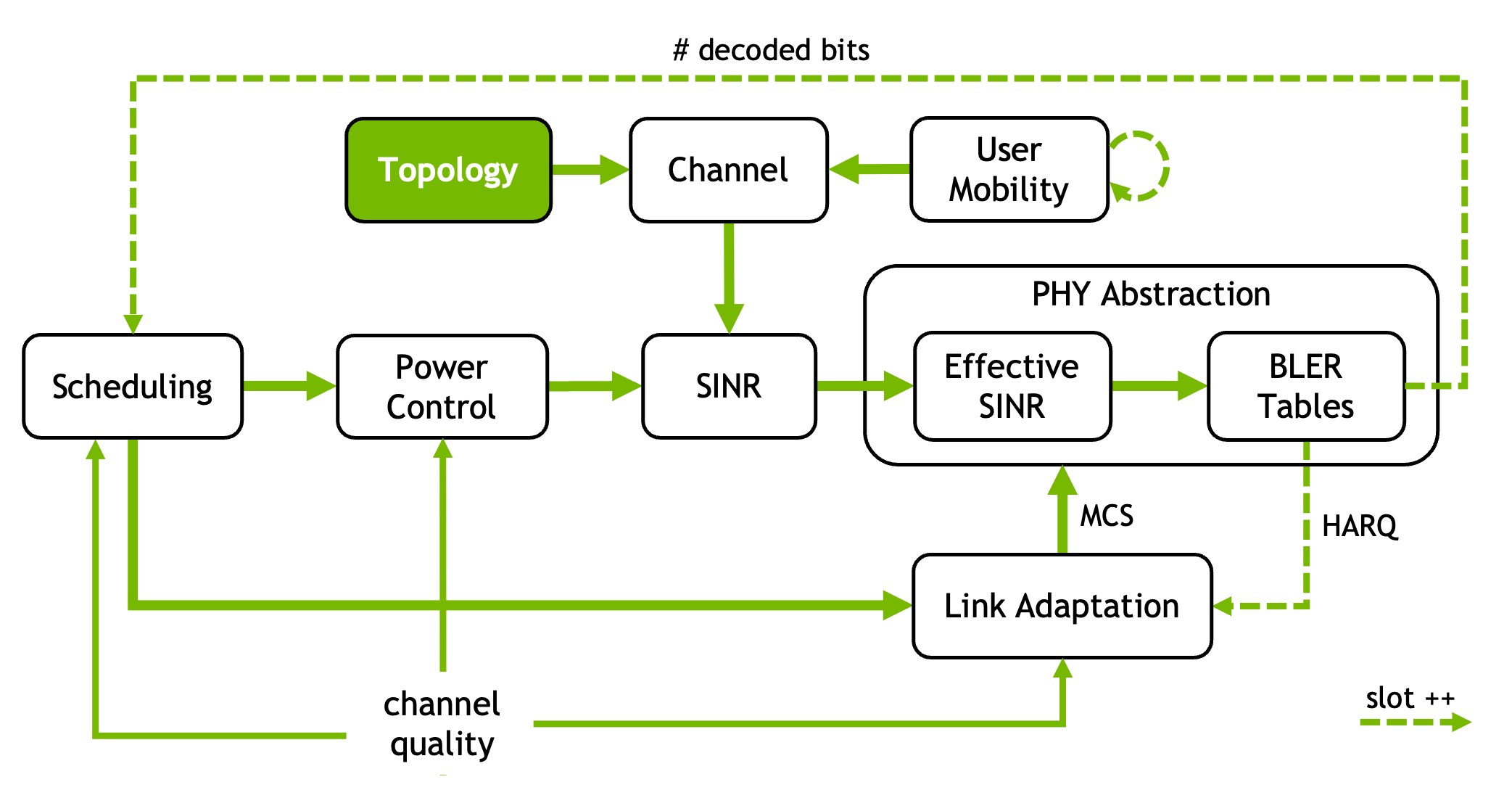
In system-level simulations with 3GPP channel modeling, it is customary to place cells on a spiral hexagonal grid. The grid is defined by the inter-site distance, determining the distance between any two adjacent hexagonal cell centers, and the number of rings of the grid, typically 1 or 2 (corresponding to 7 and 19 cells, hence 21 and 57 base stations, respectively).
To eliminate edge effects that would result in users at the cell borders experiencing reduced interference levels, the grid is usually wrapped around to create a seamless topology.
To learn how to place base stations and drop users on a hexagonal grid in Sionna, refer to the Hexagonal Grid Topology notebook.
- class sionna.sys.topology.Hexagon(radius, coord, coord_type='offset', precision=None)[source]
Class defining a hexagon placed in a hexagonal grid
- Input:
radius (float) – Hexagon radius, defined as the distance between the hexagon center and any of its corners
coord ([2], list | tuple) – Coordinates of the hexagon center within the grid. If
coord_typeis euclid, the unit of measurement is meters [m].coord_type (‘offset’ (default) | ‘axial’ | ‘euclid’) – Coordinate type of
coord
- property coord_axial
Axial coordinates of the hexagon within a grid
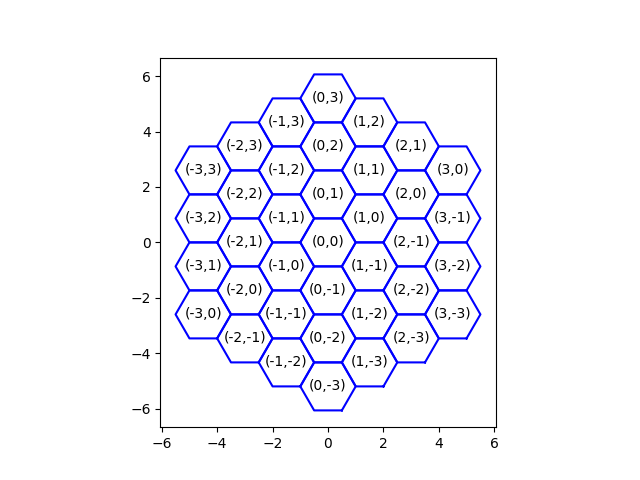
The basis of axial coordinates are 2D vectors \(\mathbf{b}^{(1)}=\left(\frac{3}{2}r,\frac{\sqrt{3}}{2}r \right)\), \(\mathbf{b}^{(2)}=\left(0, \sqrt{3}r \right)\). Thus, the relationship between axial coordinates \(\mathbf{a}=(a_1,a_2)\) and their corresponding Euclidean ones \(\mathbf{x}=(x_1,x_2)\) is the following:
\[\mathbf{x} = a_1 \mathbf{b}^{(1)} + a_2 \mathbf{b}^{(2)}\]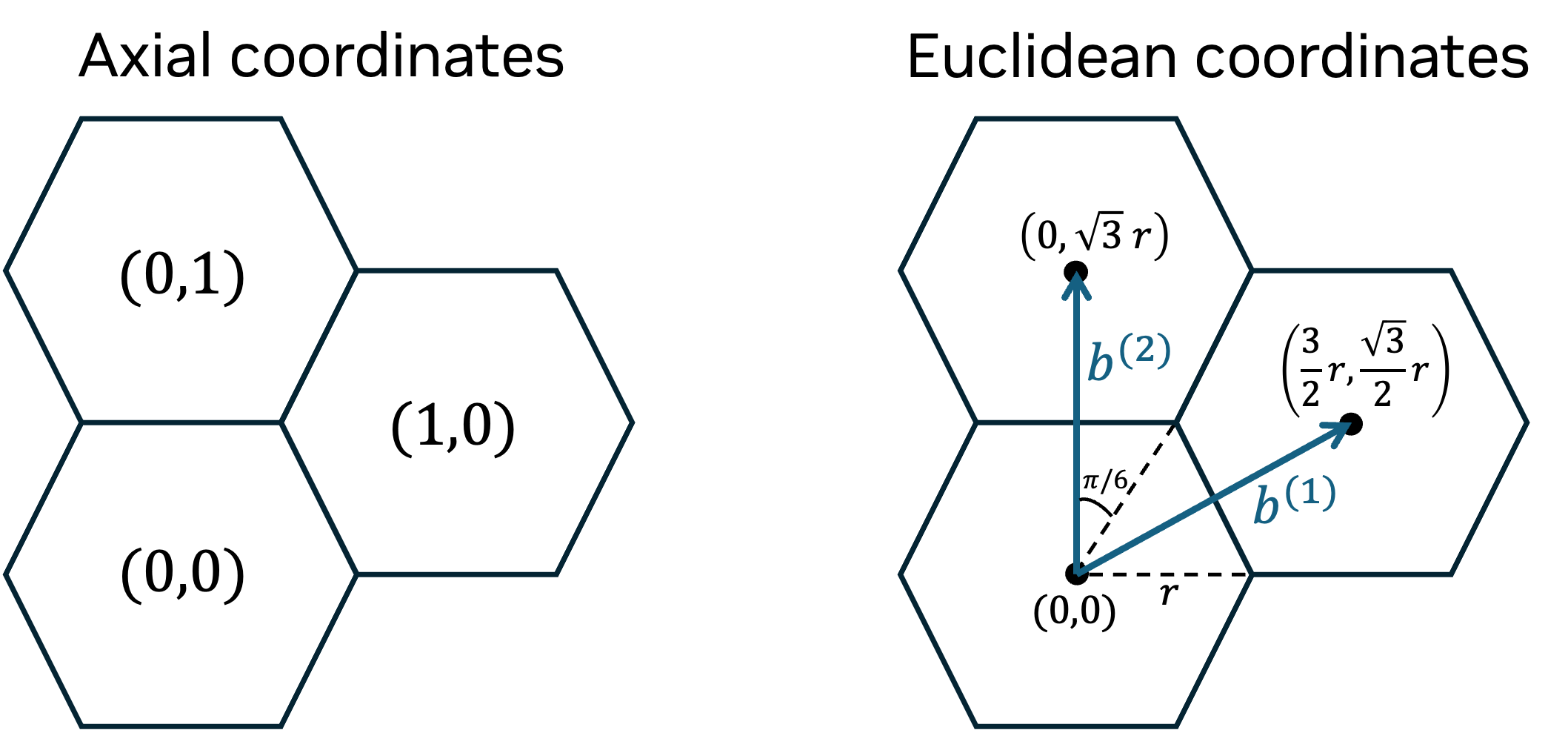
- Type:
[2], tf.int32
- coord_dict()[source]
Returns the hexagon coordinates in the form of dictionary
- Output:
dict – Dictionary containing the three hexagon coordinates, with key ‘euclid’, ‘offset’, ‘axial’
- property coord_euclid
Euclidean coordinates of the hexagon within a grid
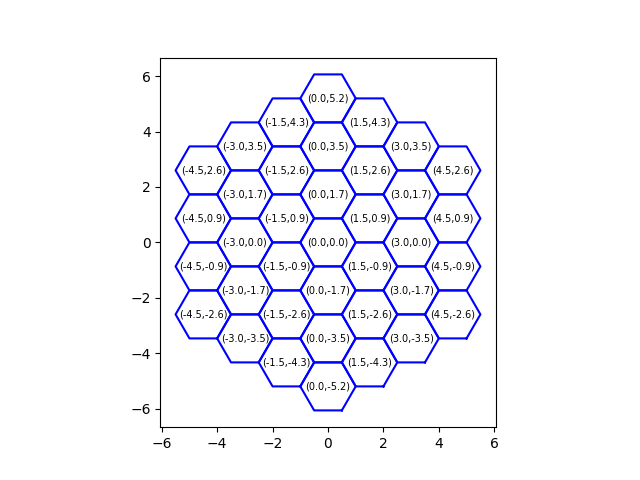
- Type:
[2], tf.float
- property coord_offset
Offset coordinates of the hexagon within a grid. The first (second, respectively) coordinate defines the horizontal (vertical, resp.) offset with respect to the grid center.
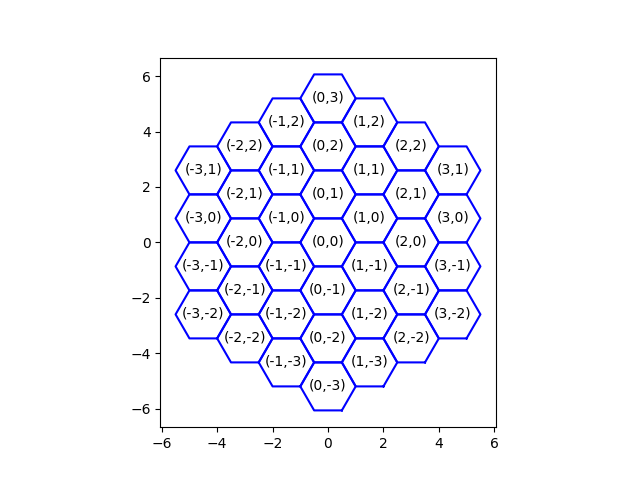
- Type:
[2], tf.int32
- corners()[source]
Computes the Euclidean coordinates of the 6 corners of the hexagon
- Output:
[6, 2], float – Euclidean coordinates of the 6 corners of the hexagon
- neighbor(axial_direction_idx)[source]
Returns the neighboring hexagon over the specified axial direction
- Input:
axial_direction_idx (int) – Index determining the neighbor relative axial direction with respect to the current hexagon. Must be one of {0,…,5}.
- Output:
Hexagon– Neighboring hexagon, in the axial relative direction
- property radius
Hexagon radius, defined as the distance between its center and any of its corners
- Type:
tf.float
- class sionna.sys.topology.HexGrid(num_rings, cell_radius=None, cell_height=0.0, isd=None, center_loc=(0, 0), center_loc_type='offset', precision=None)[source]
Creates a hexagonal spiral grid of cells, drops users uniformly at random in it uniformly at random and computes wraparound distances and base station positions
Cell sectors are numbered as follows:
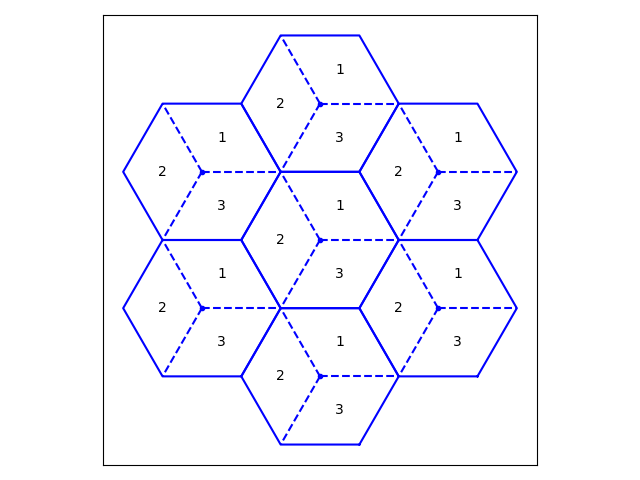
To eliminate border effects that would cause users at the edge of the grid to experience reduced interference, the wraparound principle artificially translates each base station to its closest corresponding “mirror” image in a neighboring hexagon for each user.
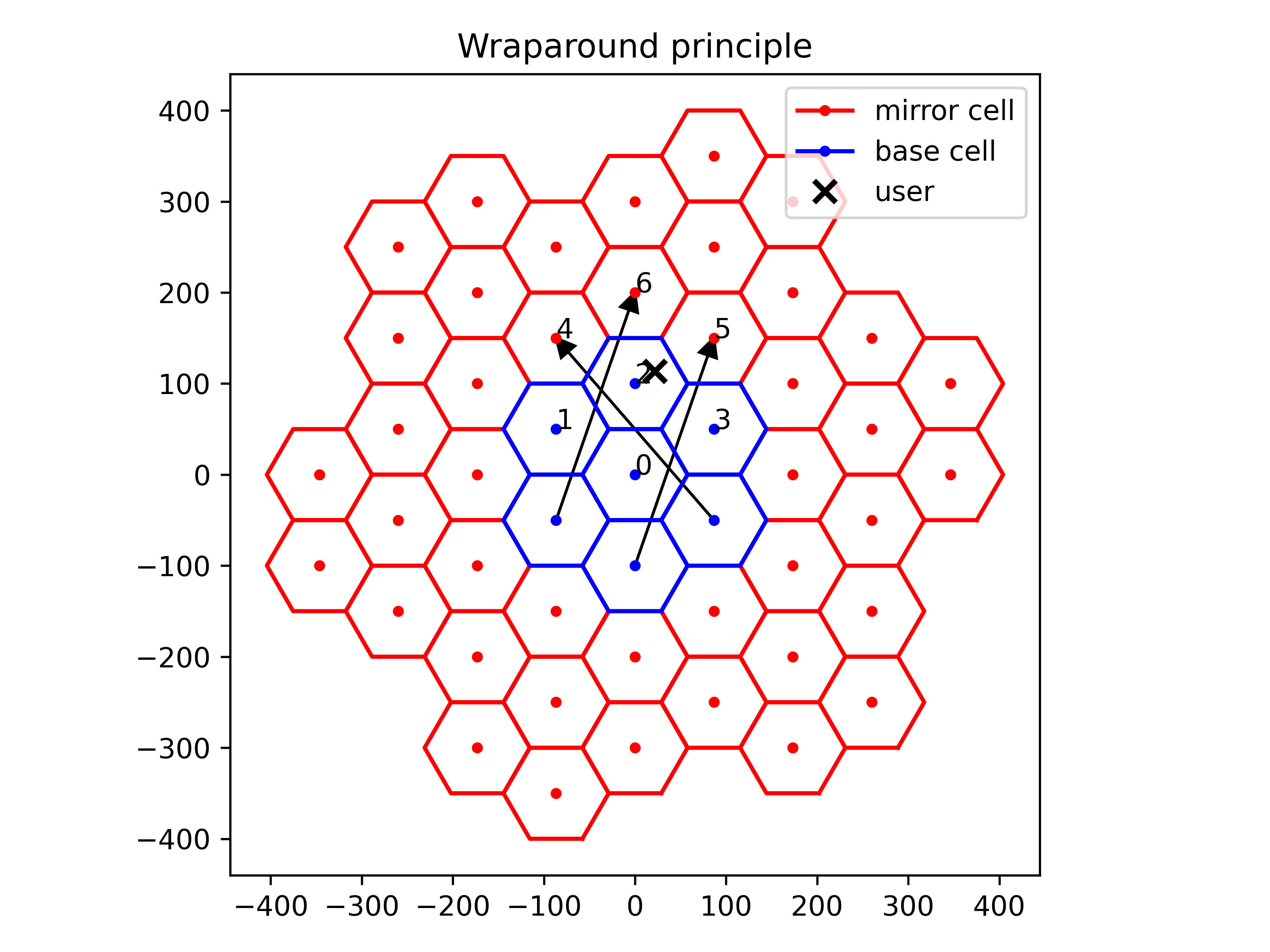
- Parameters:
num_rings (int) – Number of spiral rings in the grid
cell_radius (float | None (default)) – Radius of each hexagonal cell in the grid, defined as the distance between the cell center and any of its corners. Either
isdorcell_radiusmust be specified.cell_height (float (default: 0.)) – Cell height [m]
isd (float | None (default)) – Inter-site distance. Either
isdorcell_radiusmust be specified.center_loc ([2], list | tuple (default: (0,0))) – Coordinates of the grid center
center_loc_type ('offset' (default) | 'axial' | 'euclid') – Coordinate type of
center_coordprecision (None (default) | “single” | “double”) – Precision used for internal calculations and outputs. If set to None,
precisionis used.
- Input:
batch_size (int) – Batch size
num_ut_per_sector (int) – Number of users to sample per sector and per batch
min_bs_ut_dist (float) – Minimum distance between a base station (BS) and a user [m]
max_bs_ut_dist (float (default: None)) – Maximum distance between a base station (BS) and a user [m]. If None, it is not considered.
ut_height (float (default: 0)) – User height, i.e., distance between the user and the X-Y plane [m]
- Output:
ut_loc ([batch_size, num_cells, num_sectors=3, num_ut_per_sector, 3],
tf.float) – Location of users, dropped uniformly at random within each sectormirror_cell_per_ut_loc ([batch_size, num_cells, num_sectors=3, num_ut_per_sector, num_cells, 3], tf.float) – Coordinates of the artificial mirror cell centers, located at Euclidean distance
wraparound_distfrom each userwraparound_dist ([batch_size, num_cells, num_sectors=3, num_ut_per_sector, num_cells], tf.float) – Wraparound distance in the X-Y plane between each user and the cell centers
Example
from sionna.sys import HexGrid # Create a hexagonal grid with a specified radius and number of rings grid = HexGrid(cell_radius=1, cell_height=10, num_rings=1, center_loc=(0,0)) # Cell center locations print(grid.cell_loc.numpy()) # [[ 0. 0. 10. ] # [-1.5 0.8660254 10. ] # [ 0. 1.7320508 10. ] # [ 1.5 0.8660254 10. ] # [ 1.5 -0.8660254 10. ] # [ 0. -1.7320508 10. ] # [-1.5 -0.8660254 10. ]]
- property cell_height
Cell height [m]
- Type:
float
- property cell_loc
Euclidean coordinates of the cell centers [m]
- Type:
[num_cells, 3], float
- property cell_radius
Radius of any hexagonal cell in the grid [m]
- Type:
float
- property center_loc
Grid center coordinates in the X-Y plane, of type
center_loc_type- Type:
[2], int | float
- property isd
Inter-site Euclidean distance [m]
- Type:
float
- property mirror_cell_loc
Euclidean (x,y,z) coordinates (axis=2) of the 6 mirror + base cells (axis=1) for each base cell (axis=0)
- Type:
[num_cells, num_mirror_grids+1=7, 3], tf.float
- property num_cells
Number of cells in the grid
- Type:
int
- property num_rings
Number of rings of the spiral grid
- Type:
int
- show(show_mirrors=False, show_coord=False, show_coord_type='euclid', show_sectors=False, coord_fontsize=8, fig=None, color='b', label='base')[source]
Visualizes the base hexagonal grid and, if specified, the mirror grids too
Note that a mirror grid is a replica of the base grid, repeated around its boundaries to enable wraparound.
- Input:
show_mirrors (bool) – If True, then the mirror grids are visualized
show_coord (bool) – If True, then the hexagon coordinates are visualized
show_coord_type (str) – Type of coordinates to be visualized. Must be one of {‘offset’, ‘axial’, ‘euclid’}. Only effective if show_coord is True
show_sectors (bool) – If True, then the three sectors within each hexagon are visualized
coord_fontsize (int) – Coordinate fontsize. Only effective if show_coord is True
fig (matplotlib.figure.Figure | None (default)) – Existing figure handle on which the grid is overlayed. If None, then a new figure is created
color (str (default: ‘b’)) – Matplotlib line color
- Output:
fig (matplotlib.figure.Figure) – Figure handle
- sionna.sys.topology.gen_hexgrid_topology(batch_size, num_rings, num_ut_per_sector, scenario, min_bs_ut_dist=None, max_bs_ut_dist=None, isd=None, bs_height=None, min_ut_height=None, max_ut_height=None, indoor_probability=None, min_ut_velocity=None, max_ut_velocity=None, downtilt_to_sector_center=True, los=None, return_grid=False, precision=None)[source]
Generates a batch of topologies with hexagonal cells placed on a spiral grid, 3 base stations per cell, and user terminals (UT) dropped uniformly at random across the cells
UT orientation and velocity are drawn uniformly randomly within the specified bounds, whereas the BSs point toward the center of their respective sector.
Parameters provided as None are set to valid values according to the chosen
scenario(see [TR38901]).The returned batch of topologies can be fed into the
set_topology()method of the system level models, i.e.UMi,UMa, andRMa.- Input:
batch_size (int) – Batch size
num_ut (int) – Number of UTs to sample per batch example
scenario (“uma” | “umi” | “rma” | “uma-calibration” | “umi-calibration”) – System level model scenario
min_bs_ut_dist (None (default) | tf.float) – Minimum BS-UT distance [m]
max_bs_ut_dist (None (default) | tf.float) – Maximum BS-UT distance [m]
isd (None (default) | tf.float) – Inter-site distance [m]
bs_height (None (default) | tf.float) – BS elevation [m]
min_ut_height (None (default) | tf.float) – Minimum UT elevation [m]
max_ut_height (None (default) | tf.float) – Maximum UT elevation [m]
indoor_probability (None (default) | tf.float) – Probability of a UT to be indoor
min_ut_velocity (None (default) | tf.float) – Minimum UT velocity [m/s]
max_ut_velocity (None (default) | tf.float) – Maximim UT velocity [m/s]
downtilt_to_sector_center (bool (default: True)) – If True, the BS is mechanically downtilted and points towards the sector center. Else, no mechanical downtilting is applied.
los (bool | None (default)) – LoS/NLoS states of UTs
return_grid (bool (default: False)) – Determines whether the
HexGridobject is returnedprecision (None (default) | “single” | “double”) – Precision used for internal calculations and outputs. If set to None,
precisionis used.
- Output:
ut_loc ([batch_size, num_ut, 3], tf.float) – UT locations
bs_loc ([batch_size, num_cells*3, 3], tf.float) – BS location
ut_orientations ([batch_size, num_ut, 3], tf.float) – UT orientations [radian]
bs_orientations ([batch_size, num_cells*3, 3], tf.float) – BS orientations [radian]. Oriented toward the center of the sector.
ut_velocities ([batch_size, num_ut, 3], tf.float) – UT velocities [m/s]
in_state ([batch_size, num_ut], tf.float) – Indoor/outdoor state of UTs. True means indoor, False means outdoor.
los (None) – LoS/NLoS states of UTs. This is convenient for directly using the function’s output as input to
set_topology(), ensuring that the LoS/NLoS states adhere to the 3GPP specification (Section 7.4.2 of TR 38.901).bs_virtual_loc ([batch_size, num_cells*3, num_ut, 3], tf.float) – Virtual, i.e., mirror, BS positions for each UT, computed according to the wraparound principle
grid (
HexGrid) – Hexagonal grid object. Only returned ifreturn_gridis True.
Example
from sionna.phy.channel.tr38901 import PanelArray, UMi from sionna.sys import gen_hexgrid_topology # Create antenna arrays bs_array = PanelArray(num_rows_per_panel = 4, num_cols_per_panel = 4, polarization = 'dual', polarization_type = 'VH', antenna_pattern = '38.901', carrier_frequency = 3.5e9) ut_array = PanelArray(num_rows_per_panel = 1, num_cols_per_panel = 1, polarization = 'single', polarization_type = 'V', antenna_pattern = 'omni', carrier_frequency = 3.5e9) # Create channel model channel_model = UMi(carrier_frequency = 3.5e9, o2i_model = 'low', ut_array = ut_array, bs_array = bs_array, direction = 'uplink') # Generate the topology topology = gen_hexgrid_topology(batch_size=100, num_rings=1, num_ut_per_sector=3, scenario='umi') # Set the topology channel_model.set_topology(*topology) channel_model.show_topology()
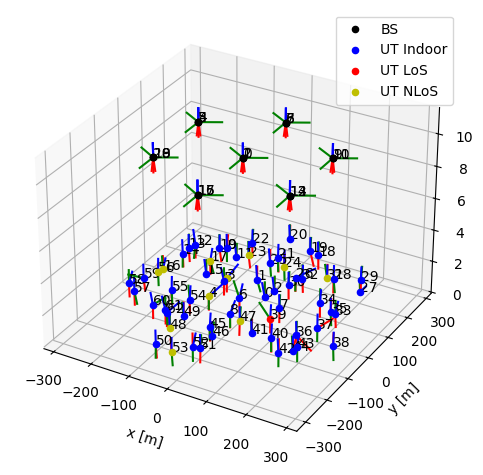
- sionna.sys.topology.get_num_hex_in_grid(num_rings)[source]
Computes the number of hexagons in a spiral hexagonal grid with a given number of rings \(N\). It equals \(1+3N(N+1)\)
- Input:
num_rings (int) – Number of rings of the hexagonal spiral grid
- Output:
int – Number of hexagons in the spiral hexagonal grid
- sionna.sys.topology.convert_hex_coord(coord, conversion_type, hex_radius=None, precision=None)[source]
Converts the center coordinates of a hexagon within a grid between any two of the types {“offset”, “axial”, “euclid”}
- Input:
coord ([…, 2], tf.int | tf.float) – Coordinates of the center of a hexagon contained in a hexagonal grid
conversion_type (‘offset2euclid’ | ‘euclid2offset’ | ‘euclid2axial’ | ‘offset2axial’ | ‘axial2offset’ | ‘axial2euclid’) – Type of coordinate conversion
hex_radius ([…], tf.float | None (default)) – Hexagon radius, i.e., distance between its center and any of its corners. It must be specified if
convert_typeis ‘offset2euclid’.precision (None (default) | “single” | “double”) – Precision used for internal calculations and outputs. If set to None,
precisionis used.
- Output:
[2], tf.float | tf.int – Output coordinates